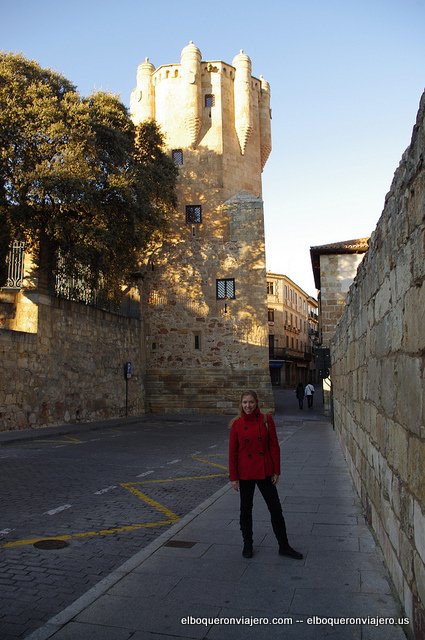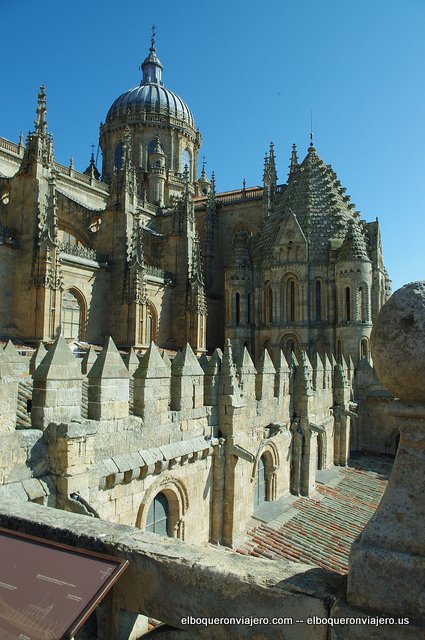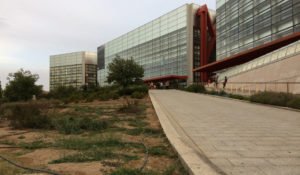Salamanca, a city that stands out for its historic and cultural heritage, and for its tapas route!

We spent another weekend in the province of Castilla Leon, this time visiting the city of Salamanca. Salamanca is a city that has been able to take its history and traditions and combine them perfectly with a modern and youthful environment that the University brings. Thanks to the help of two ruskofans (Sara and Javier Domínguez) who gave us lots of good tips, and the hotel that we chose (the NH Palacio de Castellanos, which is located right in the center of town), we had the opportunity to really immerse ourselves in all that this city has to offer its visitors.
Salamanca is a city where you could spend months and years visiting the monuments and historic buildings. We arrived on Saturday morning, and met up with our friend Sara who pointed out some of the places we should make a point to visit. And by lunch time we had decided to try some of the places on one of the more popular streets of the city: Van Dyck. We wanted to try the most places possible, but after five glasses of wine with tapas, we decided to save our energy to see some of the city.

Something that still surprises me about the cities in Castilla León, after having visited almost all of them, is the habit they have on Saturdays, which the people from the region can either confirm or deny. It seems that on Saturdays people go home to eat lunch and all the shops close. The siesta (Spanish nap time) becomes something almost obligatory. Then around eight pm the people come out in droves and the culture of tapas and pinchos can be seen in all its splendor. It’s just something I found interesting, and the people I talked to from Valladolid confirmed this custom.
As our hotel was in the center of town, we were afraid to go up to our room even to leave a few things there since there was the danger of wanting to take a siesta (especially after our lunch of tapas and wine). So we began our afternoon visit at the Convent of San Esteban. It might be one of the more historical places in the city. A monk, brother Diego de Deza (who was prior of the convent and professor of the only male son of the Catholic Monarchs) and the person who helped Christopher Columbus gain the support of the Catholic Monarchs to finance his trip to the West Indies. According to what they told us, it is the headquarters of the brotherhood famous for being the most “festive” in Salamanca´s Holy Week processions, the “Hermandad Dominica.”

After visiting the convent, we went to see the Convent of Las Dueñas, which is located close by in the very same Plaza del Concilio de Trento. The best part, without a doubt were their artisan cookies, although, obviously, its worth a visit to the convent itself, as well. I wanted to tell you about two different legends about the convent that were rather curious. The first is the “black nun”, Chikaba, who after death supposedly became white and is buried on the grounds of the convent. The other was about the underground tunnels where you could find an evil world completely different from that which is found on the surface.

If we continue walking toward the Plaza Mayor we find ourselves in Plaza Colón. Here you can find the Parish of Saint Paul, which is worth seeing inside, as well as the Tower of the Air and the Clavero Tower, as well as a statue of Christopher Columbus. The statue is positioned in such a way that it gave rise to the phrase (which rhymes in Spanish) “Where is Columbus pointing? To the Pan y Carbon Street.” We were a bit tired of so many monuments and we decided to rest in the hotel before going out that night for dinner.

Before we went to have tapas, we wanted to take in a view which already forms part of the list of our top night time photos. We crossed the Roman bridge and went down the hill to the edge of the river (avoiding different field mice and animals) and we were greeted by the reflection of the Cathedral and the bridge in the river, which acted as a mirror. Without a doubt this was the time for taking photographs, and we did our best to capture the image. For dinner, our friends took us to various bars in the historic center and we had a very nice dinner of tapas.

The next morning we woke up early to visit the rest of the city, without being rushed and time to enjoy the beautiful weather. Our first stop was going to be the Cathedrals (the old and the new). Entrance to the New Cathedral is free of charge and due to its modern style, its not as impressive as the Old Cathedral. The fee to enter the Old Cathedral is 4,75€ but it is definitely worth it. One of the most interesting parts is the Ieronimus. This is the name of an activity that was designed for the celebration when Salamanca was the Cultural Capital of Europe in 2002, and it consists of going up to the highest part of the Cathedrals in order to enjoy gorgeous views of the city and see the towers up close as well as the way the Cathedral was built.

Next we went to see the Palace of Anaya, which, today is home to the College of Philosophy and Literature, which is where Abi, who studied Spanish Literature in University, found inspiration and her best photo moments. We spent some time, along with the other tourists looking for the frog carved into the stone façade of the University. I must say that if you don´t know what you are looking for, its almost impossible to find the frog because it is very small. Since we knew where it was, we didn´t take too long to find the frog. Its said that for students, if you find the frog, on the façade, you will pass all your exams that year.

It was time for lunch and on the way to a place that our friends had ruskommended, we stumbled upon a curious and charming Little place: the Galatea bookstore. The woman in the shop ruskommended a little restaurant where we were sure to have a good lunch. After eating, we went to visit the Clerecía, but we couldn´t go inside because it turned out that the building was closed on Sunday afternoons. We were, however, able to enter the House of Shells (which is the modern day Public Library). According to the legend, underneath each of the shells on the façade there is a gold coin.

Although there was still lots to see, we decided to end our stay with a walk along the river and a rest in the garden of Calisto y Melibea, where we had some beautiful views, and, according to Fernando de Rojas, this was the place that he was inspired to write the end to his famous work “la Celestina.” For the good times we enjoyed, the good food, its history, and legends, for the number of places to visit and for its atmosphere we ruskommend the city of Salamanca with 5 boquerones.






